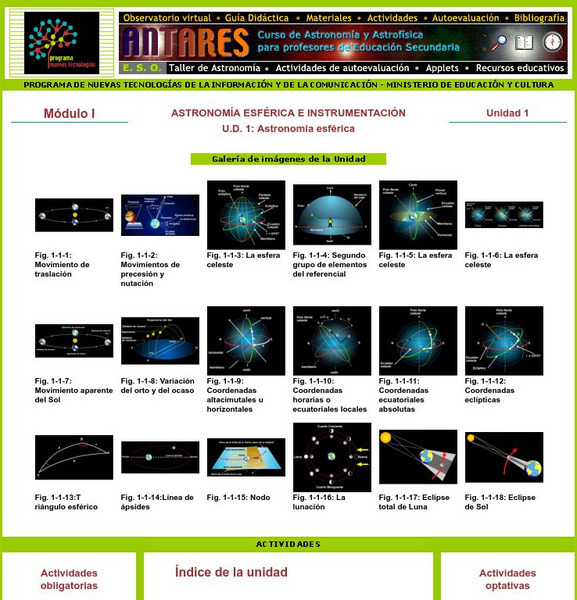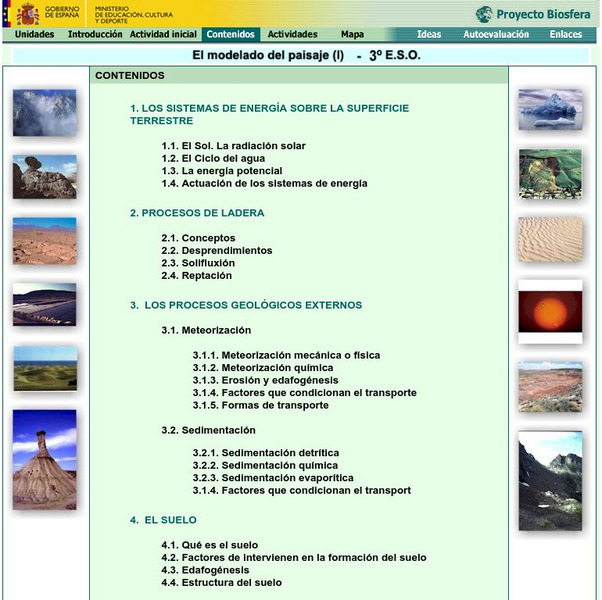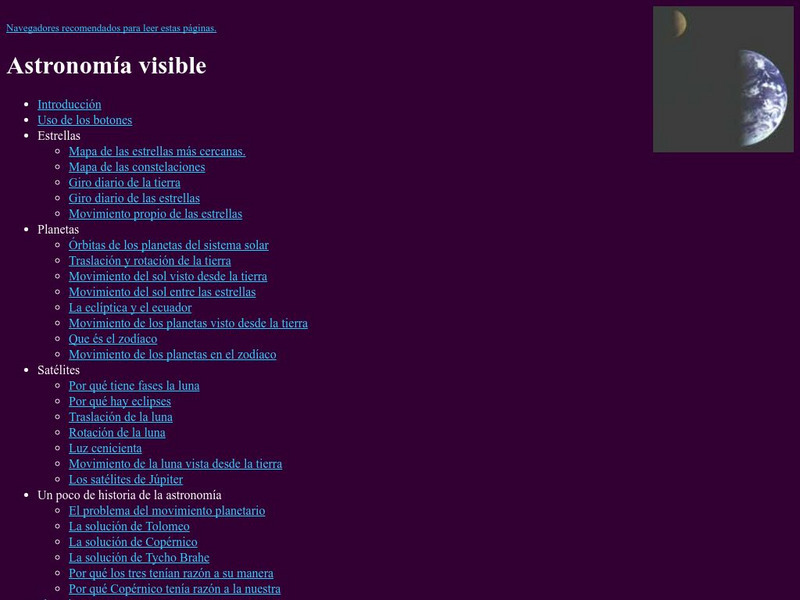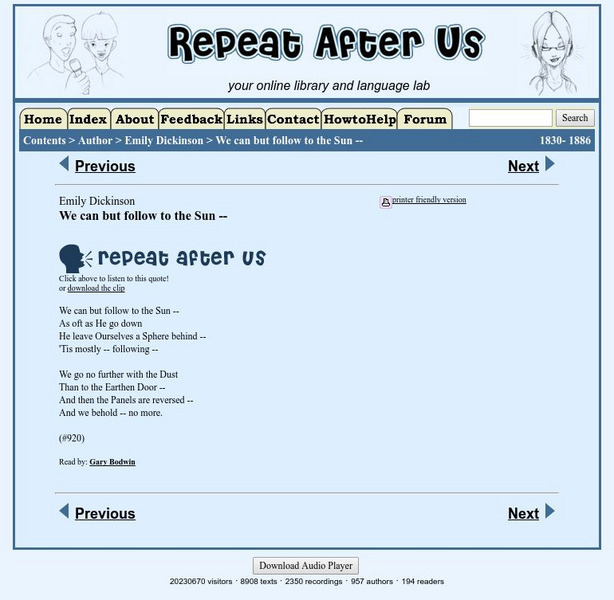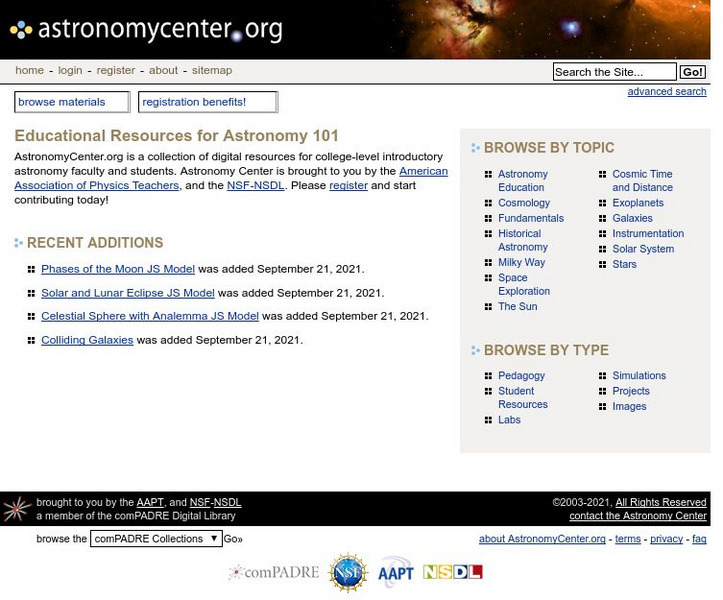Science Education Resource Center at Carleton College
Serc: How High Is Big? Using an Astrolabe
Students observe and measure the shadows of fixed objects throughout the school year to learn about how the seasonal change affects the sun's position in the sky.
Science Education Resource Center at Carleton College
Serc: Calculating the Declination of the Sun for Elementary Students
In the school courtyard, students will measure the apparent path of the sun across the sky using a toilet plunger. Students will then generate questions as to why the sun appears to move, and what is really happening in the process. We...
Science Education Resource Center at Carleton College
Serc: Experimenting With Angular Diameter and Distance (Study of Outer Space)
In studying the solar system, students compare the relative sizes of the sun and the moon, and experiment with angular diameter, apparent diameter and distance.
Ministerio de Educación (Spain)
Ministerio De Educacion: Atronomia Esferica Modulo I Unidad 1
Recognize the major constellations and learn about the sky during the different seasons of the year. You will also be able to measure the height of the mountains of the moon.
TryEngineering
Try Engineering: Here Comes the Sun
Students work in teams to learn about solar panel design, simple circuits, and how solar energy is used to provide power to simple machines such as calculators.
Ministerio de Educación (Spain)
Ministerio De Educacion: Una Estrella Llamada Sol Modulo Iv Unidad 1
In this module you will study the structure and composition of the star closest to us: the Sun.
Ministerio de Educación (Spain)
Ministerio De Educacion: El Sol Activo Modulo Iv Unidad 2
In this module you will learn about the solar cycle and study the possible influence of solar cycles on the Earth's climate.
Ministerio de Educación (Spain)
Observaciones Y Modelos en Astronomia
How does the length of the day change? How does the height of the sun change? Do we always see the same star? The answer to these questions and different observations about the sun, the moon and the stars that we can do from earth can be...
Ministerio de Educación (Spain)
Ministerio De Educacion: Astronomia Para Ninas Y Ninos
Learn basic astronomy and travel through space. After you finish the lessons you can take the evaluation to obtain the clues needed to play the fun space games.
National Institute of Educational Technologies and Teacher Training (Spain)
Ministerio De Educacion: El Modelado Del Paisaje I
This unit will discuss how the external geological agents cause the arrangement of the landscape that can be found throughout the earth. It contains 18 interactive activities.
National Institute of Educational Technologies and Teacher Training (Spain)
Ministerio De Educacion: La Situacion De La Tierra en El Universo
Throughout this unit you will make an imaginary journey that will transport you from the remotest infinity of the universe around us, to the surface of our planet. During this trip you will see the main features and components of our...
Ministerio de Educación (Spain)
Ministerio De Educacion: Astronomia Visible
This site has maps of the nearest stars and constellations. Earth and star daily rotation, proper motion of the stars and many other topics about the solar system are also shown.Read phonetically
Repeat After Us
Repeat After Us: Had I Not Seen the Sun
A poem from Emily Dickinson, "Had I Not Seen the Sun", is provided on this site. Students may listen to this poem read aloud by Sophia On and can access a printable version of this piece.
Repeat After Us
Repeat After Us: Make Me a Picture of the Sun
A poem from Emily Dickinson, "Make Me a Picture of the Sun --", is provided on this site. Students may listen to this poem read aloud by Mark Eckardt and can access a printable version of this piece.
Repeat After Us
Repeat After Us: We Can but Follow to the Sun
A poem from Emily Dickinson, "We Can but Follow to the Sun--", is provided on this site. Students may listen to this poem read aloud by Gary Bodwin and can access a printable version of this piece.
TED Talks
Ted: Ted Ed: Why Does the Sun Really Shine?
Our assumptions about the world often evolve. The rock band, They Might Be Giants, discovered this firsthand. The band has covered the 1950s song, Why Does the Sun Shine?, since 1983. In 2008, they discovered the 1950s science, which the...
PBS
Nova Teacher: Saved by the Sun: Classroom Activity
During the lesson, students will also design, build and test a solar cooker that pasteurizes water.
Harvard University
Eyes on the Sky, Feet on the Ground: The Earth's Rotation
Plenty of cool activities about the Earth's rotation can be found here, such as tracing shadows, observing shadows during different times of the day, and tracking the sun's path in the sky to understand the rotation of the earth.
American Association of Physics Teachers
Com Padre Digital Library: The Astronomy Center
A searchable collection of "curriculum materials, images, classroom demonstration, learning resources, evaluation instrumnets, and articles about approaches to astronomy education". Users can contribute materials by creating a free account.
Woods Hole Oceanographic Institution
Whoi: What Causes Tides?
The Woods Hole Oceanographic Institute provides an in-depth but easy to read article on the role of the moon and the sun in respect to tides.
National Museums Liverpool
Sundials
With this resource, students discover how sundials work. The resource links to pictures of museum quality sundials are provided as well as providing directions for making your own sundial.
PBS
Pbs Learning Media: Giant Sunspots
The sun isn't a solid yellow ball in the sky. It is a ball of boiling, churning gasses which cause the sun to have turbulent activity at times. Sunspots form in these active areas. View pictures from NASA of these giant sunspots. Also...
PBS
Wgbh/pbs: Nova Lab: Sun Lab
For those who are sun savvy, check out solar cycles and solar storms or conduct an independent investigation of behaviors of the sun.
Other
University of Cambridge: Alien Attack!
You are on a mission--find out which alien invader is trying to blow up Earth! Take part in wiping crime from the universe and feel good about yourself in the process.





